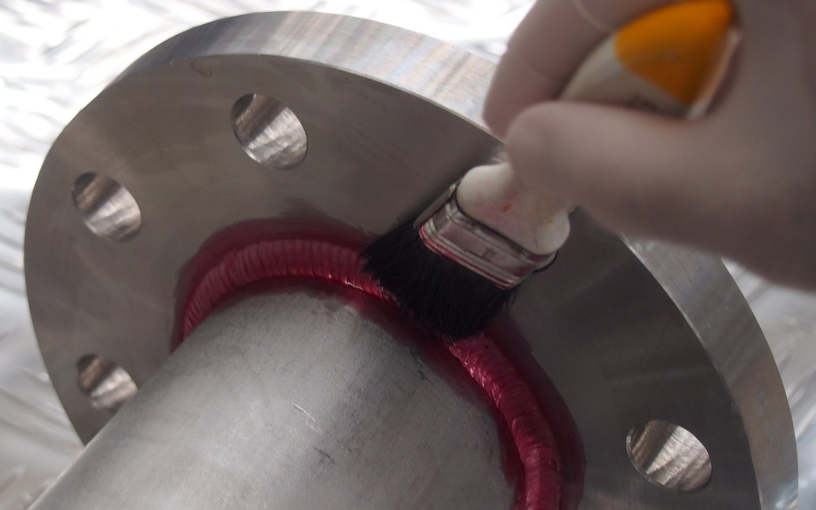Rexarc is currently open from 7:30 AM – 4:00 PM EST, Monday – Friday. Read More
Rexarc is currently open from 7:30 AM – 4:00 PM EST, Monday – Friday. Read More

Nondestructive testing (NDT), also known as nondestructive inspection (NDI), is a critical step of pressure vessel development. When a vessel is built, it has to be tested to make sure it was built properly and can be operated safely without compromising the material with destructive tests. Our guide will help you understand what some NDT techniques are, and how they are used for testing pressure vessels.
Many ways of testing the strength and durability of a material involve damaging it, so what do you do when you need to test something that needs to function after testing? The field of nondestructive evaluation was created to answer that question. NDT encompasses a wide range of techniques and strategies to identify some of the following before a product is put into use:
There are many types of nondestructive testing, and the appropriate methods will depend on the test item and the goals for testing. We’ll go over some of them in more detail to explain how they work and when they are used for pressure vessels. The four most common types of NDT are:
Visual inspection is, at its simplest, using your eyes to inspect a test item for defects or flaws. Visual inspection can also use tools like magnifying glasses, microscopes, and other nonspecialized equipment that can aid in the inspection, but the key part is using a human sense.
It is by far the most common type of NDT used across industries, but it can be more complicated than you might think. It’s not as simple as taking a quick look at something. A good visual inspection requires training to know what to look for and how to look for it, and it will depend on what exactly is being inspected.
For pressure vessels, visual inspection is almost always used to check for surface defects that might compromise the material. It’s used extensively to verify welds, usually with the addition of specialized equipment.
The main component of ultrasonic testing is sound waves. The way sound waves travel through a material can change if there are defects in the material. Ultrasonic testing involves passing sound waves through an object and measuring the echo of the wave, which occurs when it hits a material boundary like the other side of the object – or a defect.
Ultrasonic inspection is used heavily in aerospace, automotive, and manufacturing industries, and for pressure vessels. It excels at finding flaws in metals that can’t be seen visually, like defects inside the material instead of on the surface. It can also be used to measure the thickness of a material, which is helpful for monitoring the effects of corrosion without disassembling a pressure vessel.
Radiography uses radiation in the form of X-rays or gamma rays to create an image of an object. X-rays and gamma rays can pass through many materials, so an image created with them can capture defects inside an object. Voids, scratches, dents, and other changes in material thickness and quality can show up with radiographic inspection. The principle is similar to ultrasonic testing, with the exception that the radiation is measured on the other side of the object instead of measuring a reflection at the surface.
Liquid penetrant inspection is used to detect leaks, cracks, and other surface defects. It involves applying a liquid to the entire surface of an object, giving it enough time for the liquid to penetrate any surface defects, then cleaning and drying the object and applying something to the surface to draw out any of the stored liquid that didn’t get cleaned.
This makes it possible to detect surface defects in pressure vessels that would ordinarily be very hard to find visually, as well as pinhole leaks that would make the vessel inoperable.
Hydrostatic testing is used to check pressure vessels, pipes, boilers, and other systems meant to hold contents under pressure. It involves filling the system with a fluid that can’t be compressed easily, such as water (sometimes with dye added to make it easier to spot leaks), and putting the system under pressure. This forces the water out through any leaks or cracks in the system.
Pneumatic testing is similar to hydrostatic testing, but instead of using an incompressible fluid like water, it uses a pressurized gas. Common choices are air or nitrogen gas. The gas is added to the system and pressurized to the system requirements. If the pressure drops off, gas is leaking out of the system somewhere and it can be further checked for leaks.
Pneumatic testing is used in circumstances where hydrostatic testing can’t be – if the system can’t be filled with water, for instance. It can also detect much smaller leaks than hydrostatic testing can, since the gas molecules used in testing are smaller than water molecules and can pass through tinier gaps.
Rexarc is a leading manufacturer of pressure vessels made from stainless or carbon steel. If you have questions about the specifics of nondestructive testing for pressure vessels, we’re happy to answer them! Feel free to reach out to us.

We are a one stop shop from custom vessel production to full skidding, plumbing and instrumentation.

We stand by our processes and communicate with you on your project status as much or as little as you would like.

We continually reinvest in our people, business, and equipment technology to ship quality products on time.
